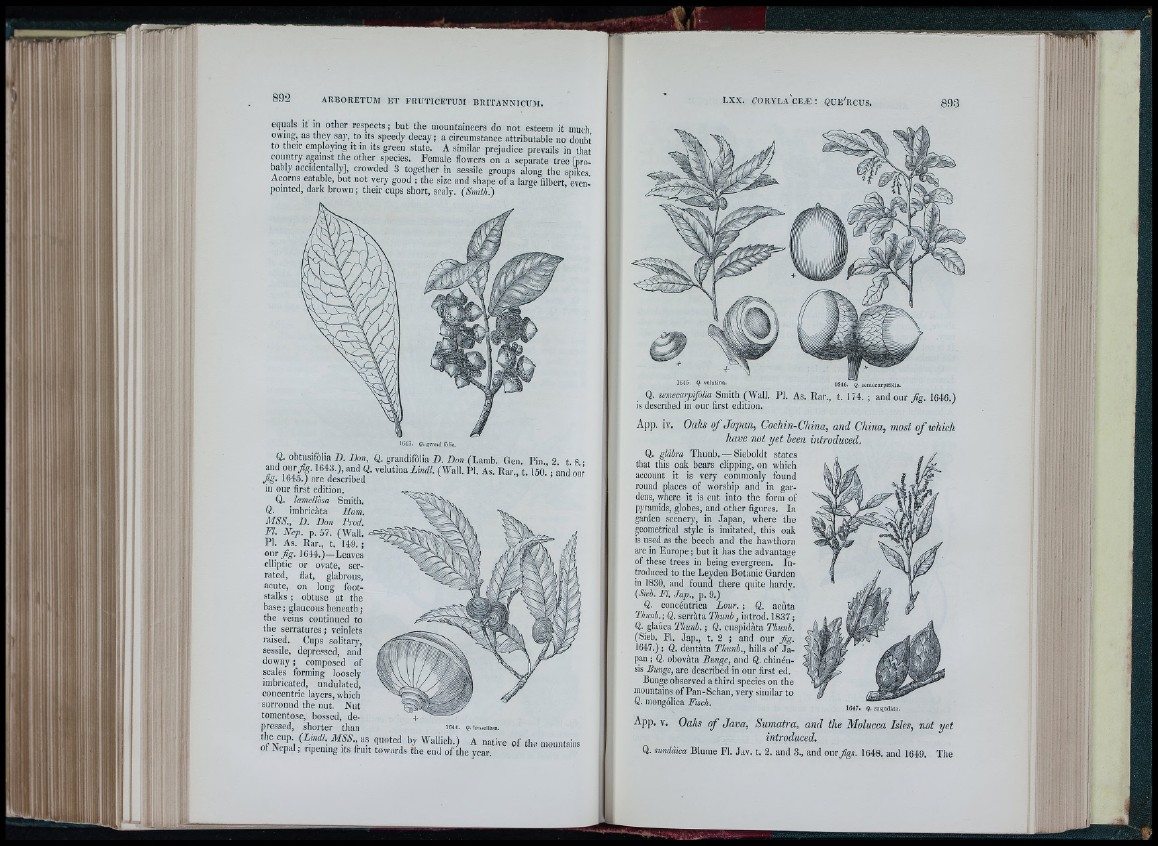
8 9 2 A R B O R E T U M E T F R U T IC E T U M B R IT A N N IC U M .
equals it in o th e r r e s p e c ts ; b u t th e mountaine ers do n o t esteem it much
owing, as th ey say,_to its speedy d e c ay ; a circumstance a ttrib u tab le no doubt
to th e ir employing it in its green state. A similar prejudice prevails in that
cou n try against th e o th e r species. Fema le flowers on a separate tre e [pro-
bably accidentally], crowded 3 to g e th er in sessile groups along th e spikes
Acorns eatable, b u t n o t very good ; th e size and shape o f a large filbert even^
pointed, dark b row n ; th e ir cups sh o rt, scaly. (Smith.)
le-lS. Q. grand fòlia.
Q. obtusifòlia D . Don, Q. grandifòlia D . Don (Lamb. Gen P in 2 t 8 •
and o u r f c . 1643.), and Q. v e l u t in a i in A (W all. P l. As. R a r., t. ISO? and oui
Jig. 1645.) are described
in o u r first edition.
Q. lamclldsa Smith.
Q. imbricata Ham.
M S S ., V . Don Prod.
F'l. N e p . p. 57. (Wall.
P l. As. R a r., t. 149. ;
o u r / g . 1644.)—Leaves
elliptic o r ovate, serrated
, flat, glabrous,
a cu te, on long footstalk
s ; obtuse a t th e
base ; glaucous beneath ;
th e veins continued to
th e s erratu re s ; veinlets
raised. Cups .solitary,
sessile, depressed, and
d owny ; composed o f
scales forming loosely
imbricated, undulated,
con c en tric layers, which
su rro u n d th e nut. N u t
tomentose, bossed, d e p
ressed, sh o rte r than leii. «. i?n(fjtòsa.
! f n T I 'i "• Z " " " ‘fo -) A native ol JNcpal; ripening its friut towards th e end o f th e year. c f th e mountaliis
LXX. CORYLA CEJE : Q U E 'r cU S . 8 9 S
16Í5. «.velutina. 1546. q. semecarpifòlia.
Q. semecarpifòlia Smith (W all. P l. As. R a r., t. 174. ; and o u r / g . 1646.)
is described in o u r first edition.
App. iv. Oaks o f J a p a n , Cochin-China, a n d China, most o f which
have not y e t been introduced.
Q. glabra Th u n b . — S ieboldt states
that this oak bears clipping, on which
account it is very commonly found
round places o f worshij) an d in gardens,
where it is c u t in to th e form of
pyramids, globes, an d o th e r figures. In
garden scenery, in J ap an , where th e
geometrical style is imitated, this oak
is used as th e beech and th e hawthorn
are in Europe ; b u t it has th e advantage
of these trees in being evergreen. In-
fi-oduced to th e Leyden Botanic Garden
in 1830, and found th e re quite hardy.
(Sieb. Fl. Ja p ., p. 9.)
Q. concéntrica Lour. ; Q. acùta
Thunb.; Q. se rrà ta T h u n b , in tro d . 1837 ;
Q. glauca Thunb. ; Q. cuspida ta Thunb.
(Sieb. F l. Jap., t. 2 ; and o u r fig .
1647.) ; Q. d en tà ta Thunb., hills o f J a pan
; Q. obovàta Bunge, aud Q. chinénsis
Bunge, are described in o u r first ed.
Bunge observed a th ird species on th e
mountains o f P an -S ch an , very similar to
Q. mongólica Fisch. ® 1647. «. ccspklàta.
App. V. Oaks o f J a v a , S um a tra , a n d the Molucca Isles, not y e t
introduced.
Q. sundàiea Blume Fl. Jav. t. 2. and 3., and o m fig s . 1648. and 1649. The